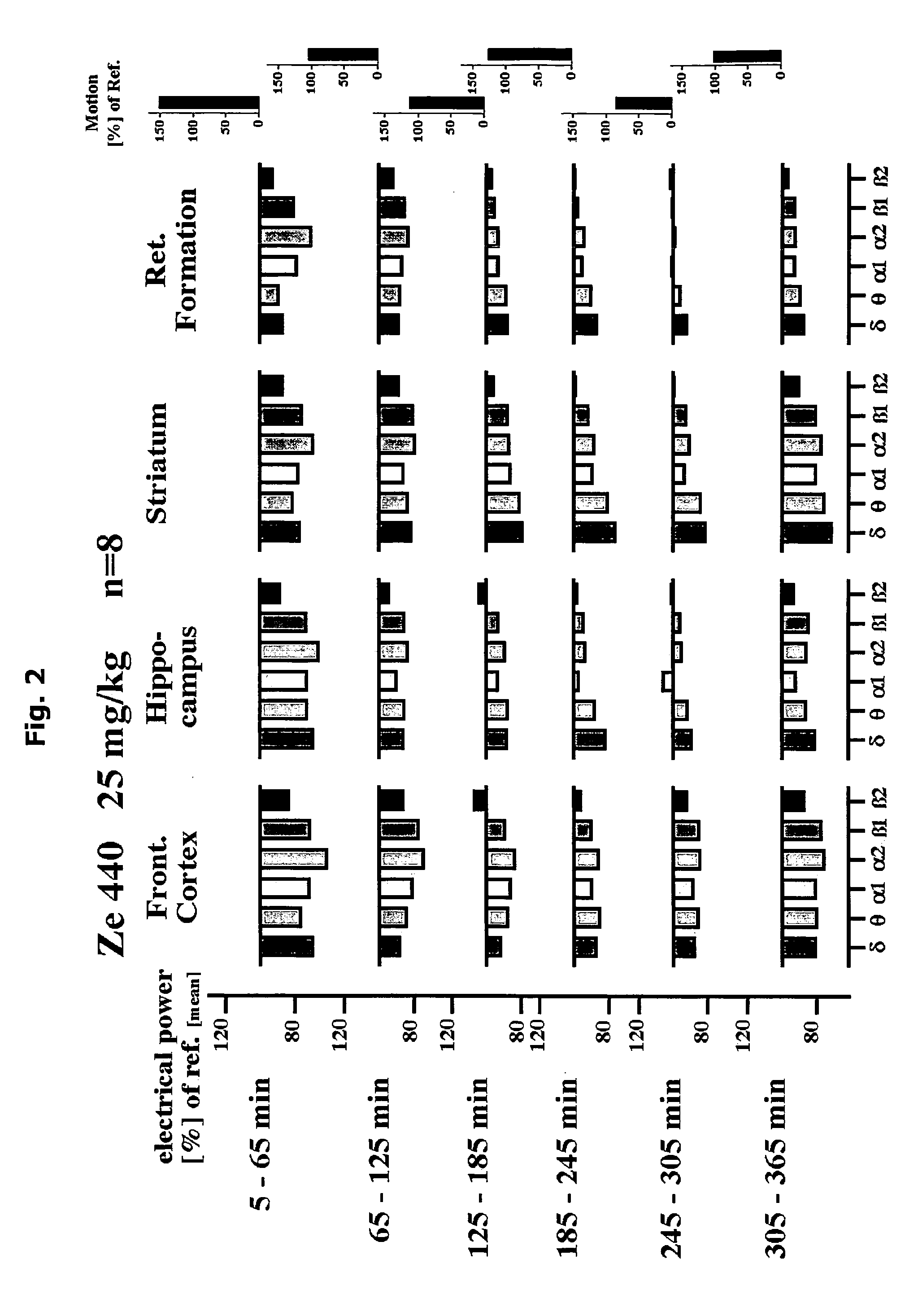Use of vitex agnus castus extracts for preparing a medicament
a technology of vitex agnus and extract, which is applied in the direction of biocide, plant growth regulator, plant ingredients, etc., can solve the problems of eliciting marked dyskinesia, affecting the effect of agnus agnus, and affecting the effect of agnus agnus, and all dopamine agonists have a rather large number of serious adverse effects
- Summary
- Abstract
- Description
- Claims
- Application Information
AI Technical Summary
Benefits of technology
Problems solved by technology
Method used
Image
Examples
example 1
[0063]In order to demonstrate that VAC extract Ze 440 of Zeller AG is actually active within the central nervous system (CNS) after oral administration at the D2 receptor as well as the D3 receptor subtypes, experiments in chronically instrumented, freely moving animals were performed. Field potentials were recorded from several brain areas (cortex, hippo-campus, striatum, reticular formation) and, in addition, the locomotor activity was monitored after oral administration of the VAC extract.
Material and Methods
Experimental Procedures
[0064]Eight adult Fisher rats (about 6 month of age and day—night converted) were implanted with 4 bipolar concentric steel electrodes within a stereotactic surgical procedure. All four electrodes were placed 3 mm lateral within the left hemisphere. Anterior coordinates are 12.2, 5.7, 9.7 and 3.7 mm for frontal cortex, hippocampus, striatum and reticular formation (according to the atlas of Paxinos and Watson, 1982). A base plate carrying the electrodes...
example 2
[0074]This example demonstrates the strong binding affinity of various VAC extracts (60% ethanol, v / v) (Ze 440) to human recombinant dopamine D3 receptors (IC50 values are approximately 5 μg / ml). The comparison of standardised Ze 440 VAC extracts of eight different batches revealed similar potency of binding inhibition to D3 receptors. In addition to the similar phytochemical profile determined by HPTLC, these results support the dual concept of standardisation combining pharmacological and phytochemical data in order to maintain a constant quality of phytomedicinal drugs. The results further indicate that the dopaminergic action of VAC extracts is also due to dopamine D3 receptors in addition to the earlier proposed D2 receptors.
Experimental Procedures
[0075]Human recombinant dopamine D3 receptor was expressed in CHO cells as previously described (Lundstrom & Turpin, Proposed schizophrenia related gene polymorphism: expression of the Ser9Gly mutant dopamine D3 receptor with the Seml...
example 3
[0077]This example is directed to an observational clinical study on humans for evaluating the efficacy of orally administered VAC extracts for relieving movement disorder symptoms, in this case RLS symptoms, in patients previously treated with dopamine agonists.
[0078]Six patients with mild to medium RLS symptoms previously treated with dopamine agonists or L-Dopa received two dosages of 20 mg ZE 440 extract tablets every evening by oral administration. The progression of RLS symptoms was investigated according to the evaluation questionnaire for Restless Leg Syndrome (International RLS severity scale (IRLS)) as set forth in the Leitlinien der Deutschen Gesellschaft für Neurologie; Restless Leg Syndrom (“Guidelines of the German Society of Neurology; Restless Leg Syndrome”). The evaluation of the questionnaires demonstrated that the patients experienced a substantial amelioration of RLS symptoms and did not require conventional synthetic dopamine agonists. The study is still ongoing...
PUM
 Login to View More
Login to View More Abstract
Description
Claims
Application Information
 Login to View More
Login to View More - R&D
- Intellectual Property
- Life Sciences
- Materials
- Tech Scout
- Unparalleled Data Quality
- Higher Quality Content
- 60% Fewer Hallucinations
Browse by: Latest US Patents, China's latest patents, Technical Efficacy Thesaurus, Application Domain, Technology Topic, Popular Technical Reports.
© 2025 PatSnap. All rights reserved.Legal|Privacy policy|Modern Slavery Act Transparency Statement|Sitemap|About US| Contact US: help@patsnap.com



